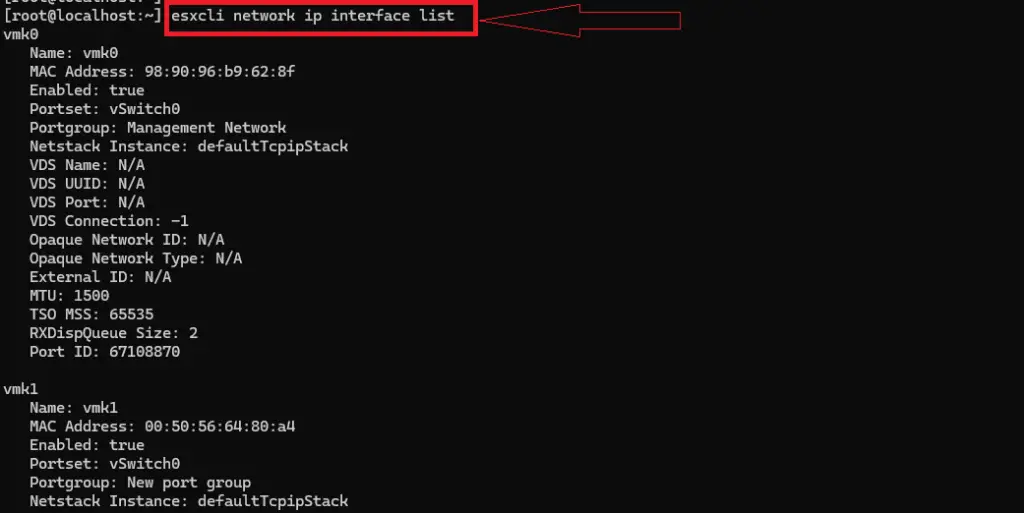Introduction to ESXi Shell Commands
The ESXi Shell provides a command-line interface that allows administrators to execute various tasks and configurations, giving them unparalleled control over their VMware infrastructure. In this comprehensive guide, I will walk you through the fundamentals of ESXi Shell commands, providing you with the knowledge and skills necessary to master this powerful tool.
Understanding the ESXi Shell
The ESXi Shell provides a direct command-line interface to the underlying ESXi operating system. It allows administrators to perform both simple and complex tasks without relying solely on the graphical user interface (GUI). By accessing the ESXi Shell, you can execute commands that enable you to monitor and manage your virtualized infrastructure efficiently.
esxcli network ip interface list
The command esxcli network ip interface list is used to display information about all VMkernel network interfaces on the system. This command provides details such as network information, port group, MTU (Maximum Transmission Unit), and the current state for each virtual network adapter in the system. It is a useful command for obtaining an overview of the network interfaces configured on the ESXi host.

esxcli network ip interface ipv4 get
The command esxcli network ip interface ipv4 get is used to display information about the IPv4 settings of a specific VMkernel network interface on a VMware ESXi host. This command provides details such as the IPv4 address, subnet mask, gateway, and other relevant IPv4 configuration parameters for the specified VMkernel interface. It is a useful command for retrieving and verifying the IPv4 settings of a particular network interface on the ESXi host.

esxcfg-nics -l
The command esxcfg-nics -l is used to list physical network adapters (NICs) and their link state on a VMware ESXi host. This command provides information about the physical NICs, including their names, link states (up or down), and other relevant details. It is a useful command for administrators to view the status and configuration of network adapters on an ESXi host.

Show the ARP table
The command esxcli network ip neighbor list is used to display the ARP (Address Resolution Protocol) table on a VMware ESXi host. This command provides information about the IP addresses and corresponding MAC addresses of devices that are directly reachable via the network interfaces on the ESXi host. The ARP table is essential for mapping IP addresses to MAC addresses for efficient communication within a network.

Show the Routing Details
the command esxcli network ip route ipv4 list is used to display the current routing table configuration on a VMware ESXi host.The key points about this command are:
- It lists the current IPv4 routing table on the ESXi host, including the network, netmask, gateway, and interface for each route.
- This command is useful for viewing the existing static and dynamic routes configured on the ESXi host.
- The output of this command can be used to verify the routing configuration and identify any issues or missing routes.
- The command can be used in conjunction with other “esxcli network ip route ipv4” commands to add, remove, or modify routes on the ESXi host.
- The routing table information displayed by this command is essential for understanding and troubleshooting network connectivity issues on the ESXi host.
ESXi Shell Commands for Resource Management
Resource management is crucial for maintaining the performance and stability of your virtualized environment. ESXi Shell commands allow administrators to effectively allocate and monitor resources, ensuring that virtual machines receive the necessary computing power and storage. In this section, we will explore commands that enable you to manage CPU, memory, and storage resources, as well as monitor resource usage and troubleshoot resource-related issues.
Conclusion: Mastering ESXi Shell Commands for Enhanced Virtualization Skills
In conclusion, mastering ESXi Shell commands is instrumental in elevating your virtualization skills to new heights. By understanding the fundamentals of the ESXi Shell, exploring a comprehensive list of commands, and delving into various sections covering networking, virtualization, resource management, and security, you will gain the expertise necessary to manage your VMware infrastructure with confidence and efficiency. So, embrace the power of ESXi Shell commands and unlock the full potential of your virtual environment.


